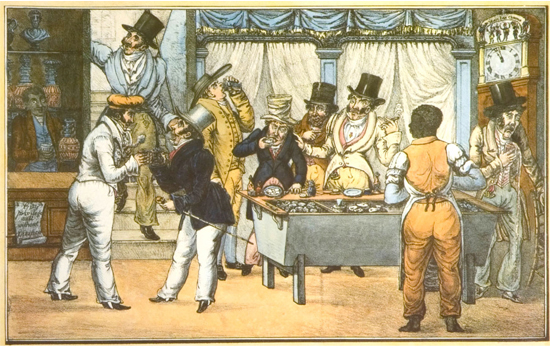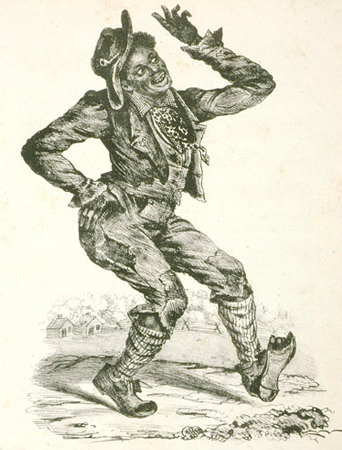Symposium Information
SYMPOSIUM INFORMATION
REFRAMING THE COLOR LINE:
RACE AND THE VISUAL CULTURE OF THE ATLANTIC WORLD
AN EXHIBITION AND SYMPOSIUM
SYMPOSIUM SCHEDULE
FRIDAY, OCTOBER 30. 1:00 P.M. – 4:30 P.M.
HISTORY DEPARTMENT, 1014 TISCH HALL.
WELCOME.
J. Kevin Graffagnino. Director. The William L. Clements Library.
PANEL I.PARODY AND PUBLIC CULTURE.
Chair. Paul Farber, Program in American Culture, University of Michigan
Samuel Otter. University of California, Berkeley. Department of English.
“Have You Any Flesh Coloured SilkStockings?: Re-Viewing Edward W. Clay’s ‘Life in Philadelphia.’“
Corey Capers. University of Illinois, Chicago. Department of History.
Reading Bobalition: Toward a Genealogy of Satiric Public Blackness.
Comment. Jean Hébrard. École des Hautes Études en Sciences Sociales, Centre de Recherches sur le Brésil Contemporain, and University of Michigan, Institute for the Humanities.
PANEL II.SEEING GENDER AND SEXUALITY.
Chair. Christa Holm Vogelius, Department of English, University of Michigan.
Erica Armstrong Dunbar. University of Delaware. Department of History and Black American Studies Program.
Reading, Writing, and Womanhood: Representations of African American Women in the Antebellum City.
Elise Lemire. SUNY at Purchase. Department of Literature. Edward Clay’s “Practical Amalgamation” Series.
Comment. Rebecca Zurier. University of Michigan. History of Art.
FRIDAY, OCTOBER 30. 4:30 – 6:00 P.M.
CLEMENTS LIBRARY.
RECEPTION AND VIEWING OF REFRAMING THE COLOR LINE.
SATURDAY, OCTOBER 31. 9:30 A.M. – 1:00 P.M.
HISTORY DEPARTMENT, 1014 TISCH HALL.
PANEL III. TRANS-ATLANTIC MIGRATIONS.
Chair. Rachel Afi Quinn. Program in American Culture. University of Michigan.
Jasmine Nicole Cobb. University of Pennsylvania. Annenberg School for Communications.
Race in the Trans-Atlantic Parlor: Diffusions of “Life in Philadelphia.”
Martha S. Jones. University of Michigan. Department of History, Center for Afroamerican and African Studies, and Law School.
Trans-Atlantic Visions: The Case of Haiti’s Faustin Soulouque.
Comment. Susan L. Siegfried. University of Michigan. History of Art.
PANEL IV. CURATOR’S ROUNDTABLE: ARCHIVING RACE AND VISUAL CULTURE
Chair. Aston Gonzalez. Department of History, University of Michigan.
Georgia B. Barnhill. Andrew W. Mellon Curator of Graphic Arts & Director, Center for Historic American Visual Culture. American Antiquarian Society.
Phil Lapsansky, Curator of African American History, Library Company of Philadelphia.
Clayton Lewis. Curator of Graphic Materials, William L. Clements Library, University of Michigan.
SATURDAY, OCTOBER 31. 2:00 – 4:00 P.M.
CLEMENTS LIBRARY.
BEHIND THE SCENES AT THE CLEMENTS LIBRARY.
With Clayton Lewis, Curator of Graphic Materials. (Program participants only.)
SPEAKERS
COREY CAPERS teaches Early American History and African American Studies from the Seventeenth to the mid-Nineteenth Century. Among the courses he has recently taught are: Ritual, Print and Politics in Eighteenth-Century Anglo-America; Authority, Resistance and Power in Early America; Black Lives in Revolution; and A History of Punishment: From Early Modern Europe to the Nineteenth-Century U.S. His primary areas of interest are in racial practice, print culture and citizenship during the Revolution and Early Republic as reflected in his dissertation, Black Voices/White Print: Race-making, Print Politics and the Rhetoric of Disorder in the Early National U.S. North. He is currently working on his book project entitled Public Blackness: Racial Practice, Publicity and Citizenship in the U.S. North, 1776 – 1828 as well an article entitled “Reading Bobalition: Racial Publicity and the Shaping of Democratic Order, 1816 – 1834.”
JASMINE NICHOLE COBB is a doctoral candidate in the Annenberg School for Communication at the University of Pennsylvania. Her dissertation, “Racing the Trans-Atlantic Parlor,” considers representations of Black women in popular culture of the early nineteenth century. More broadly, her writing and research focuses on race, gender, and visual culture.
ERICA ARMSTRONG DUNBAR specializes in 19th century African American and Women’s History. She received her B.A. from the University of Pennsylvania in 1994 and her Ph.D. from Columbia University in 2000. Her first book is entitled: A Fragile Freedom: African American Women and Emancipation in the Antebellum City (Yale University Press, 2008). She is currently working on her next book length project that focuses on African Americans and mental illness in the 19th century.
MARTHA S. JONES is Associate Professor of History and Afroamerican Studies, and Visiting Professor of Law at the University of Michigan, Ann Arbor. Jones is the author of All Bound Up Together: The Woman Question in African American Public Culture, 1830-1900(2007), which examines nineteenth-century debates over the rights of women. She directs the Law and Slavery and Freedom Project, an international research collaborative with Rebecca J. Scott (Michigan) and Jean Hébrard (EHESS). Her current book length project is Overturning Dred Scott: Everyday Life at the Intersection of Race and Law in an Antebellum City. Jones is co-curator of the exhibition Reframing the Color Line, with Clayton Lewis of the Clements Library.
ELISE LEMIRE is the author of two books on race in the antebellum Northeast. “Miscegenation”: Making Race in America, originally published in 2002, was recently reissued in paperback by the University of Pennsylvania Press. Black Walden: Slavery and Its Aftermath in Concord, Massachusetts was published this past spring, also by the University of Pennsylvania Press. She is the recipient of several fellowships, including two year-long fellowships from the National Endowment for the Humanities. Educated at Yale and Rutgers and now Associate Professor of Literature at SUNY Purchase, Dr. Lemire is currently working on a book about the largest mass arrest in Massachusetts history, which took place when Vietnam Veterans Against the War attempted to camp on the Lexington Battle Green.
SAMUEL OTTER has taught in the English Department at the University of California at Berkeley since 1990. His research and teaching focus on nineteenth-century United States literatures. He is particularly interested in the relationships between literature and history, the varieties of literary excess, and the ways in which close reading also can be deep and wide. He has published Melville’s Anatomies (1999), in which he analyzes Melville’s concern with how meanings, particularly racial meanings, have been invested in and abstracted from human bodies. He recently finished a book entitled Philadelphia Stories, in which he examines the narratives about race, character, manners, violence, and freedom that unfold across a range of texts written in and about Philadelphia between 1790 and 1860.
Reframing the Color Line, the Symposium, is supported by the Office of the Provost; the Public Goods Council; Arts at Michigan; the Program in American Culture; the Atlantic Studies Initiative; the Rackham Graduate School Visual Culture Workshop; and the Rackham Graduate School Atlantic Studies Workshop


